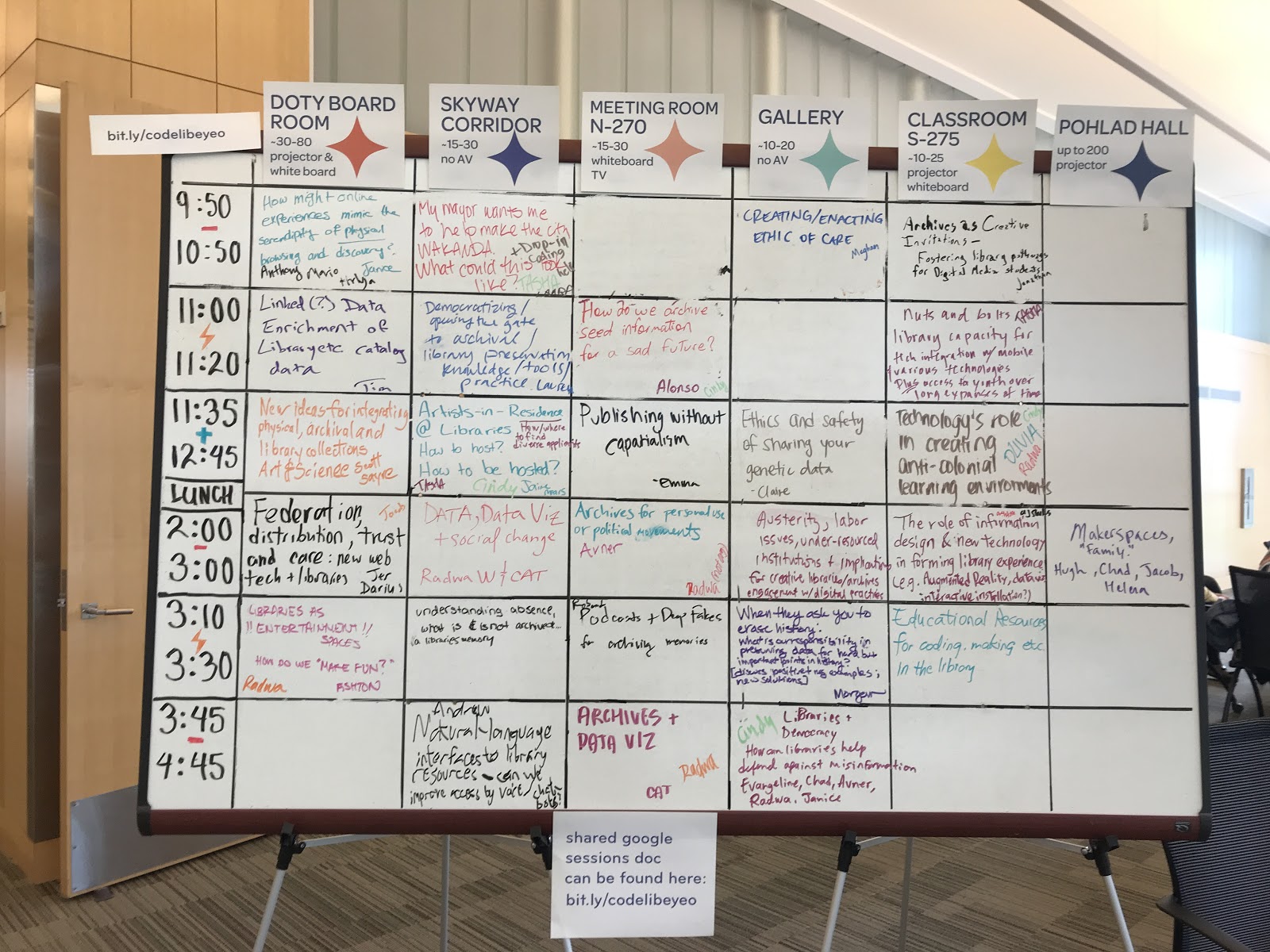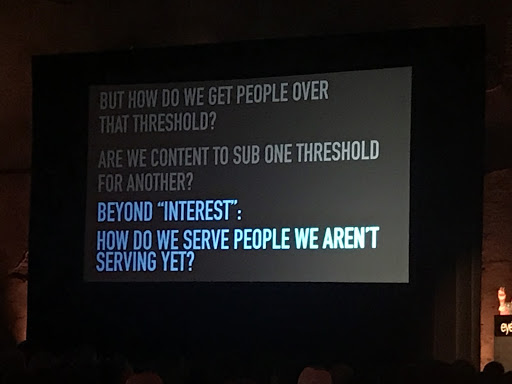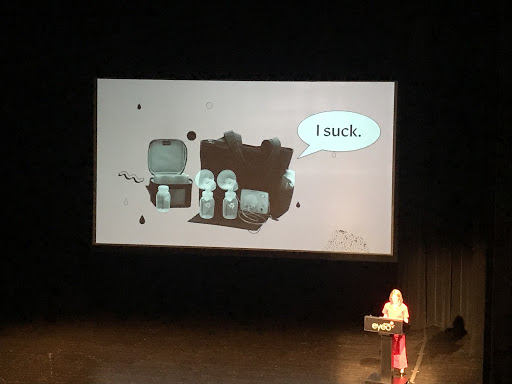I first heard about Eyeo through a recommendation by Chris Cerrito, New Media Exhibit Developer at the Exploratorium. He said that this conference was by far one of the best that he’s ever attended for creative technologies.
After a mind-blowing past week, I have to concur with him. The talks, the people that I met, and the incredible work being done in the field were so *simulate brain & heart exploding*. In comparison to attending SXSW in the spring, this was a much more intimate and wholesome experience. Nobody was trying to sell me anything or sign me up for a newsletter I would never read. People were vulnerable with their work and supportive of each other’s experiences. In addition, this conference focused a lot more on social justice issues and inclusivity in design. All attendees were provided with a pronoun sticker to add to their badge, which I thought was such a simple, but impactful idea.
I applied and was accepted as a student volunteer for the festival, which allowed me to attend without having to pay for the badge (yay broke grad student life!). Although, I had to work the festival, I was still able to attend most talks that I wanted to see. Actually, working the festival was a great ice breaker for conversations. Nothing like being recognized as the girl who’s been sprinting the mic up and down the stairs for Q&As.
On Day 1, I signed up to volunteer at the Code+Libraries Summit, an unconference about the intersection of coding and libraries. I chose to volunteer here because I knew nothing about coding or libraries. They both skirted my personal interests: STEAM education and museums, so why not find out what’s on the periphery?
In the morning, attendees proposed their own talks and then created their own schedule. Examples of talks included:
“My Mayor Wants Me to Help Make the City “Wakanda” - What Could This Look Like?”
“Technology’s Role in Creating Anti-Colonial Learning Environments”
“Libraries as “Entertainment” Spaces - How Do We “Make Fun?”
“The Role of Information Design & New Technology in Forming Library Experience (e.g. AR, data viz, interactive installations)”
In the second talk listed above, we had some intense conversations. I had no idea what I had walked into (I thought I was actually attending a different talk). We discussed whether oppressors could provide the tools for the oppressed to free themselves. People from the City Innovation Team in Austin argued vehemently that we were pushing STEM propaganda onto young diverse students, that the education system was just preparing those students to work at the bottom of the STEM-based jobs. They were strongly against the use of technology to liberate and argued for grassroots methods and community organization. Per their words, they wanted to “burn [technology] all down.”
As someone who is passionate about reaching diverse audiences, I had never heard this view before. It was completely valid and I had never considered it. I was fascinated as to me why people who were so against technology were attending a technology conference. So during the first networking event, I approached the team and asked them. They talked about the rapid gentrification occurring in Austin and the implementation of STEM education programs to “solve the problem.” They didn’t like what was happening, but they couldn’t control it. Instead, they chose to know more about what was happening so that they could be knowledgeable and mitigate the damage.
Lucianne Walkowicz, an Astronomer at the Adler Planetarium gave the keynote speech, and I’m pretty sure that I fell in love. She discussed how access to education is not equitable, and how we have a threshold problem. People won’t get up to the threshold even if it’s good content, because they don’t think it’s for them. She asked: “On any given day, you can have an unplanned encounter with art or literature out in the world, whether it’s through public sculpture, or a quote carved above a building doorway. But what about science?” She discussed her experiments at the intersection of art, science, and experience.
Her keynote made me think of “The Art of Relevance” by Nina Simon, where she asked how do you create more doors to content instead of creating new rooms? How do we create more encounters with science in people’s everyday lives? (Also, shoutout to Story Collider! Hear my Story Collider talk here.)
I attended a talk by Catherine D’Ignazio, a scholar, artist, and software developer who focuses on data literacy, feminist technology, and civic engagement. Having personal trouble finding a place to breastfeed while working at MIT, and struggling with the painful process, she started a hackathon to make the breast pump not suck. I found out that there is better technology to pump cows, than there are to pump humans (which is messed up!). She discussed how missing data sets have created systemized oppression, and lauded the use of data to challenge power. She asked “how do we use our power and privilege to design for collaboration?
Over the course of the week I was able to attend many talks from Mike Tucker’s (Magic Leap) talk on “New Doors of Perception: Explorations Into Mixed Reality” to Meow Wolf’s talk on building “Your Own Multiverse.” Mike Tucker shared their company’s new technology and work. Pushing for the consideration of sound as augmented reality as well as visuals. Meow Wolf talked about their painful growth as an arts collective into an entertainment and arts group.
Nicole Aptekar’s stunning work.
Nicole Aptekar’s talk “A Line Taut Against a Curved World” was one of my favorites. She shared her growth as an artist, and was incredibly vulnerable in her talk. She talked about how she struggled for years, not thinking that she was an artist, even as she created art. She shared how after producing one of her best pieces, she grappled with feeling like she could never produce anything as good again.
This is something that I’ve personally struggled with. As a kid, I loved making art, but as I got older, I got more hesitant in creating. Putting my pen to paper, meant that I was committing to the judgement of others. In that was the fear that I would finally be told what I thought was true, which is that I wasn’t good enough. I tend to gravitate towards doing things that I’m good at, not necessarily what might make me happy. As an adult, I’m trying to break this bad habit, forcing myself to do things that I might not be good at, but to do them unapologetically.
Refik Anadol’s talk on “The Space in the Mind of a Machine,” was also incredible. He shared his work which can be found at http://refikanadol.com/. His work was stunningly beautiful, using machine learning and projection mapping to create artistic representations of data that were incredibly moving.
While all the talks were incredible, one of my favorite parts of the conference was by far the attendees! It was a humbling experience to be surrounded by all of these amazing people in the creative technology field. I met Chad Smith, who works on developing VR experiences for the Space Telescope Science Institute (we had mutual acquaintances at NOVA!). Danced around with Matt Brown and his singing sock puppets (see evidence in the video below). Got to play mini golf with Daniel Schiffman from The Coding Train. And learned all about algoraves, live coding rave concerts.
I felt extremely lucky to have the opportunity to meet these people and learn about what they were doing. Everyone was so nice and willing to share their pieces of advice. The conference was well set-up with many networking opportunities to make conversations organic and free-flowing. Nothing like a riveting game of mini-golf to equalize hierarchies.
I would highly recommend anyone interested in the intersection of art, technology, design, and social justice to attend this conference. While it is smaller, the networking opportunities alone are worth the attendance. You can network while making origami, playing board games, or skee ball. And besides just the talks, Show & Tells and Meet-Ups throughout the conference provide plenty more opportunities to learn about other people’s work. 10/10 would go again.
The best way I can describe it is by something that another attendee said to me. On the first night, I met an attendee that was at her 6th Eyeo conference. I asked her what brought her back every year. She told me that the first time that she came, she felt like she had found her people. That’s exactly how I felt at eyeo, that these were my people.




